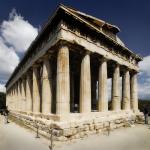|
This section contains 3,016 words (approx. 11 pages at 300 words per page) |

|
Dionysian Festivals.
In Athens, there were three days of tragedies and satyr plays, and one day of comedy produced at the great festivals of the City Dionysia in March and the Lenaean Festival in January. In addition there were the festivals of Rural Dionysia, held in honor of Dionysus outside Athens in the towns and villages of the countryside each December. The rural festival in Piraeus, the port town of Athens, was particularly famous. The difference was, however, that whereas new plays were presented at the festivals in Athens, the Rural Dionysia festivals generally had older more familiar plays. Tragedy, comedy, and satyr plays each had its own dances. The main dance associated with tragedy was the emmeleia, a term which covered a number of dance patterns and postures. The dance of the satyr plays was the sikinnis, performed by men costumed...
|
This section contains 3,016 words (approx. 11 pages at 300 words per page) |

|




